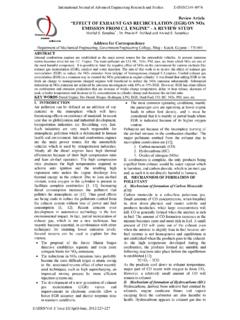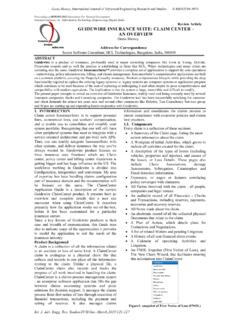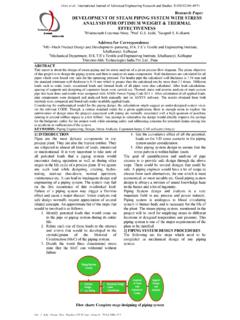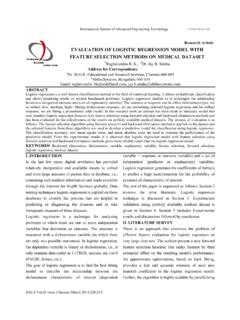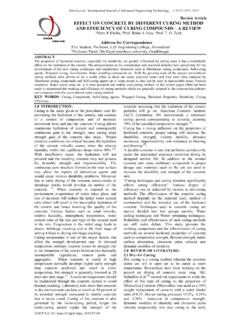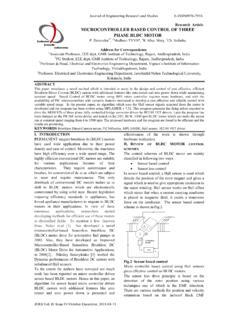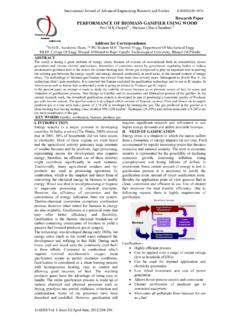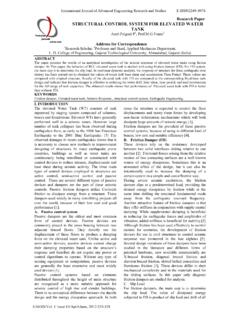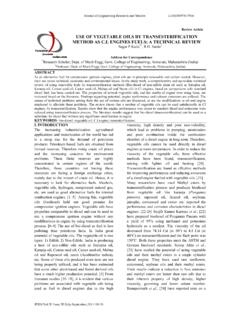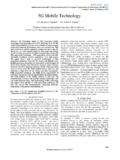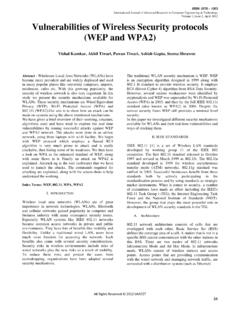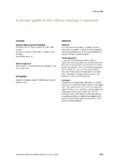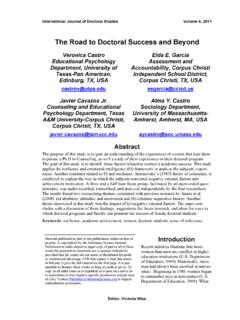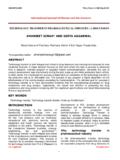Transcription of International Journal of Advanced Engineering …
1 International Journal of Advanced Engineering technology E-ISSN 0976-3945 Issue IV/October-December, 2011/231-238 research Article ERGONOMIC DESIGN OF HAND TOOL (SCREWDRIVER) FOR INDIAN WORKER USING COMFORT PREDICTORS: A CASE STUDY 1 Chandra Arunesh* 2 Chandna Pankaj Address for Correspondence 1 Associate Professor, Department of Mechanical Engineering , Krishna Institute of Engineering & technology , Ghaziabad- 201206, Uttar Pradesh, (INDIA) 2 Associate Professor, Department of Mechanical Engineering , National Institute of technology , Kurushetra- 136119, Haryana, (INDIA) ABSTRACT The purpose of this paper is to focus on certain important aspects of screwdriver use in occupational work situations, with an emphasis on comfort/discomfort in using screwdriver according to users.
2 Descriptors of comfort/discomfort in using hand tools were collected from literature and interviews. Six comfort factors could be distinguished (functionality, posture and muscles, irritation and pain of hand and fingers, irritation of hand surface, handle characteristics, aesthetics). These six factors can be classified into three meaningful groups: functionality, physical interaction and appearance. It is concluded that functionality and physical interaction are the most important factors of comfort in using screwdriver. Thus the designers can use to address the appropriate comfort descriptors in the hand tool design process; an attempt is made to illustrate the relevance of anthropometric data in the design of handle of hand tools (screwdriver) using ergonomic principles. The modified ergonomic designed handle of screwdriver will allow higher working efficiency and more torque than conventional handle.
3 KEYWORDS: Comfort; Hand tools, Handle Design, Anthropometric 1. INTRODUCTION Hand tools have been in use for a very long time and have developed in an almost evolutionary manner. The first recorded use of the screw principle was an invention by Archimedes about 300 BC. By the first century BC, very large wood screws were in use, while metal screws began to appear during the fifteenth century. With the increasing use of wood, screws came the need for a screwdriver, which at first was a slot-bladed bit used with a drill. Fraser [1] states that the handled screwdriver did not appear until the nineteenth century). Today, manually driven screwdrivers look very much the same as a century ago. Over the years, much effort and research Pheasant and O Neil [2]; Greenburg and Chaffin [3]; Tichauer and Gage [4]; Huston et al.
4 [5]; Mital [6]; Johnson and Childress [7]; Mital and Channaveeriah [8]; Radwin et al. [9]; and Ulin et al. [10] has been devoted to the exploration and understanding of the interrelationship between human capability performance and hand tool design, in order to ensure that hand tools are used more effectively, accurately, comfortably and safety. The purpose has also been to develop ergonomic guidelines for designing new tools or redesigning existing ones however, hand tools are still involved in many industrial accidents and injuries that are costly, severe and frequent. Aghazadeh and Mital [11] found that the upper extremities are injured more often than any other part of the body. Some hand tools likewise screwdrivers have changed very little over the years. To some extent, this is due to tradition or the belief that many years of experience with common tools would have produced an implement optimally suited to human use with no room for improvement.
5 Through the years, hand tools have also not been sufficiently adjusted to the changes in human anthropometric measures. In industrially developing countries (IDCs), the majority of the population is engaged in industrial activities, some in small-scale enterprises and relatively few in factory. Much of the power required for industrial activities, such as for opening and tightening of screws by the electrician, maintenance fitter, lathe machine, computer numerically operated machines in industries is derived from human energy. Most of these industrial activities can cause fatigue and work-related illnesses, which in turn reduce productive capacity. Christensen and Bishu [12] state that the hand tools are still the primary interface for operators at work, in spite of all the automation efforts made by modern industry.
6 In the past, hand tool design was focused on tool function in order to improve task efficiency and allow for standardization. Aptel and Claudon [13]; and Marsot and Claudon [14] explained that the tool should perform the task that it was designed for and respond to the needs of the greatest possible number of users. In recent years, emphasis is placed on the role of the user to do the job harmlessly, effortlessly and comfortably. Vink et al. [15] found that especially, comfort is a topic of interest for manufacturers of hand tools, as it is thought to play a role in product buying decisions. Further Kuijt-Evers et al. [16] discussed that comfort can contribute to the task performance of the workers. The multi-disciplinary nature of ergonomics can play a unique role in the protection of people's health and in the prevention of work-related health hazards.
7 Ergonomics can do this by integrating concepts from the social sciences with technological advances to enhance productive capacity and improve people's health. The use of hand tool (like screwdrivers) frequently leads to feeling of discomfort during work. Fellows and Freivalds [17] described that these International Journal of Advanced Engineering technology E-ISSN 0976-3945 Issue IV/October-December, 2011/231-238 feelings of discomfort can reduce efficiency and job satisfaction of workers. Chao et al. [18] and [11] discussed that on a longer term, the use of hand tools can also cause musculoskeletal disorders for these reasons, employers are interested in comfortable hand tools for their employees. Meanwhile, manufactures recognize comfort as a major selling point, as it is thought to play an increasingly important role in product buying decisions.
8 Therefore, they pay more attention to the design of comfortable hand tools, which reduce the risk of occupational injury and result in high product quality for customers, and of course, comfort for users. The major question here is, how to design hand tools that are characterized by much comfort for the user. Before one can design a comfortable hand tool, it is important to know what end-users actually mean by comfort in using hand tools and how this can be addressed in the design process. Kuijt-Evers et al. [19] discussed the meaning of comfort in using hand tools to the end-users in his previous study. This consists of a list of 40 descriptors of comfort. Those descriptors were associated with comfort by hand tool users and formulated in the end-users own words, like: the hand tool fits the hand, has a good force transmission, and has a nice feeling handle [19].
9 These comfort descriptors can help to focus on the most urgent customer needs during the design process. The first factor contains descriptors as reliable, functional, task performance, ease in use, safe etc. labeled as functionality factor. The second to the fifth factor correspond to the physical interaction between user and hand tool: posture and muscles (factor 2), irritation and pain of hand and fingers (factor 3), irritation and hand surface (factor 4) and handle characteristics (factor 5). The sixth factor is about the aesthetics, containing descriptors such as professional looks, styling, nice colour, and solid looks. For screwdrivers, the relative importance of these descriptors was determined [19]. From the results of that study, it was seen that comfort in using screwdrivers was associated with ease in use , nice feeling handle , low hand grip force supply , functionality and causes cramped muscles (The last descriptor was negatively associated with comfort).
10 The underlying factors of comfort in using screwdrivers were determined by dividing the (interrelated) descriptors into factors using principal components analysis (PCA). The most important factors for comfort pointed out to be functionality and physical interaction, and adverse body effects, while aesthetics was of minor influence. The primary purpose of this paper is to focus on certain important aspects of screwdriver use in occupational work situations. Moreover, the relative importance of the thirty comfort descriptors and underlying factors are identified for screwdriver. A screwdriver hold in a power grip; users apply a high torque force on screwdrivers (resulting in shear forces between hand and handle). The secondary aim of this research was to compare the dimensions of screwdriver available in marketplace with the hand anthropometric database of industrial worker of Haryana state of India and to suggest the optimal dimensions.
